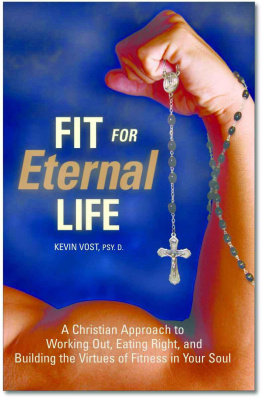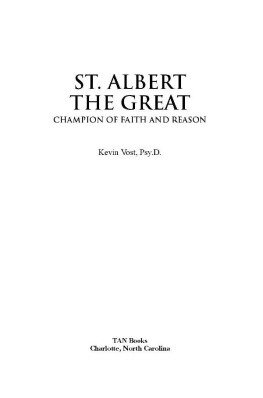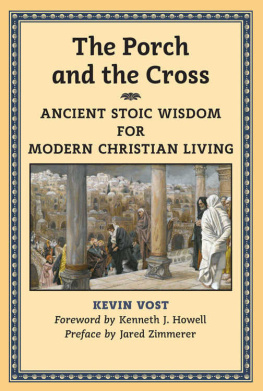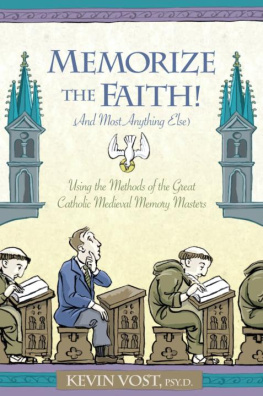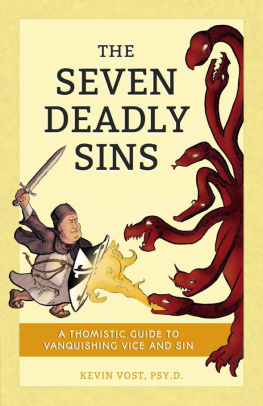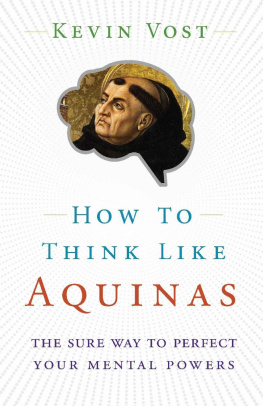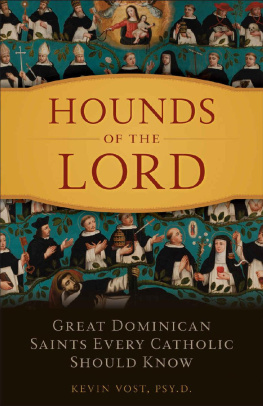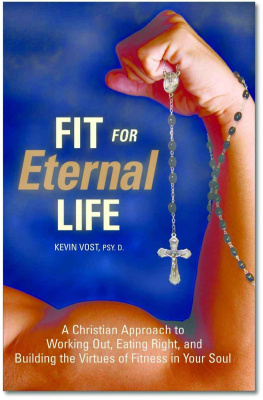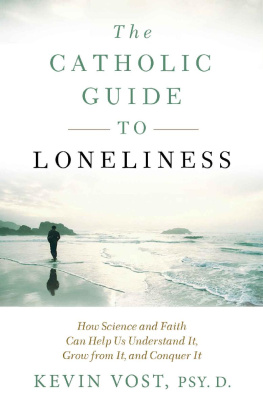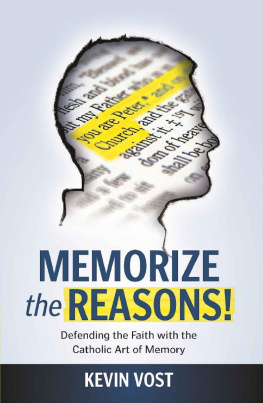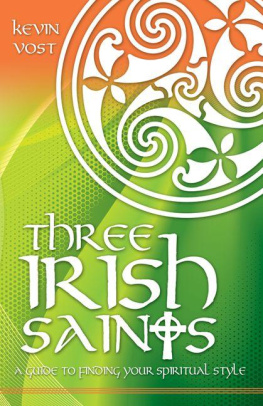Fit for Eternal Life
A Christian Approach to Working Out, Eating Right, and Building the Virtues of Fitness in Your Soul
Kevin Vost, Psy.D.
SOPHIA INSTITUTE PRESS
Manchester, New Hampshire
Copyright 2007 Kevin Vost
Printed in the United States of America
All rights reserved
Cover design by Theodore Schluenderfritz
No part of this book may be reproduced, stored in a retrieval system, or transmitted in any form, or by any means, electronic, mechanical, photocopying, or otherwise, without the prior written permission of the publisher, except by a reviewer, who may quote brief passages in a review.
Sophia Institute Press
Box 5284, Manchester, NH 03108
1-800-888-9344
www.SophiaInstitute.com
Library of Congress Cataloging-in-Publication Data Vost, Kevin.
Fit for eternal life : a Christian approach to working out, eating right, and building the virtues of fitness in your soul / by Kevin Vost.
p. cm.ISBN 978-1-933184-31-9 (pbk. : alk. paper)
1. Physical fitness Religious aspects Christianity. I. Title.BV4598.V67 2007
248.4 dc22200703862207 08 09 10 11 12 9 8 7 6 5 4 3 2 1
He has shown strength with his arm.
Luke 1:51
To Kathy Ann (Collins) Vost: a young lady of beautiful form and sweetness of soul, whom I met at the gym in the Spring of 83
Acknowledgments
This book would be mostly blank if I had been unable to draw upon the wisdom of the unlikely collection of philosophers, theologians, exercise theorists, and nutrition experts youll meet in the pages ahead. My task is merely to help you literally flesh out their ideas in stronger muscles, sturdier bones, more powerful hearts, and more devout souls.
On a personal level, I cant thank enough all of the men and women who over the years have come under my guidance as a weightlifting teacher, fitness instructor, or training partner. This book would not be possible without your sufferings (and, I hope, your results).
Many thanks also to Todd Aglialoro of Sophia Institute Press. He surprised me when he suggested a book on physical and spiritual fitness only weeks after Id begun collecting my thoughts (and quotations) for just such a mind/body tome. His skill and patience in seeing this book through to a finished product did not surprise me.
Authors Note
We want you to be fit for eternal life, not to get there before your time! The information in this book is intended for healthy men and women. But even people without known health problems should consult their physician before starting any new exercise or dietary program. The material in this book is not a substitute for the advice of a personal healthcare professional. Any application of the advice in this book is at the readers sole discretion and risk. The author and publisher disclaim any liability, personal, professional, or otherwise, resulting from the application or misapplication of the suggestions in this book.
Foreword
Be Perfect
Do you not know that your body is a temple of the Holy Spirit within you, which you have from God? You are not your own; you were bought with a price. So glorify God in your body. I Corinthians 6:19 You, therefore, must be perfect, as your heavenly Father is perfect. Matthew 5:48 The Church, without any doubt whatever, approves of physical culture, if it be in proper proportion. Pope Pius XII
Since youve picked up this book, I suspect that you are already someone striving for spiritual perfection. Thank God for that. But meanwhile, have you let your body fall into a state of disrepair?
Perhaps youve become too accustomed to swimming against the current of our modern world, with its vain and superficial glorification of physical appearance. Or maybe work and family obligations have just left you too busy to get to the gym.
Or, maybe youve been putting so much focus on things spiritual that your body has gone neglected. After all, why should we waste time wrapping our hands around a barbell when we could be folding them in prayer? Shouldnt we be whipping our bodies, rather than whipping them into shape?
Not according to St. Paul. In his letter to the Corinthians, he tells us to treat the body as the Temple of the Holy Spirit, and to glorify God with it. God gave us our body as a most precious gift, and it is our Christian duty to care for it indeed, to perfect it. In so doing, we show due reverence to the Holy Spirit who dwells within.
Of course, the modern world usually errs in the opposite extreme: treating the body as a god rather than as the dwelling-place of God. Physical indulgence and pleasure reign. But pious souls need not leave the world of the body to the hedonists. Yes, spiritual things are higher, but God made us beings of both body and spirit , now and for eternity. We are ashes to ashes, dust to dust, its true, but please recall: at the end of time, we are to be resurrected, soul and body.
The Glorified Body
Thats surely why, in his Summa Theologica , St. Thomas Aquinas (the saint most closely connected to things of the mind) spends dozens of pages examining scriptural, traditional, and philosophical insights regarding the nature of our glorified body. He gives reasoned answers to all kinds of questions, from whether we will all arise with bodies of the same age and stature, to whether we will have internal organs, hair, and nails!
In Question 84 to the Supplement of the Summa Theologica , On the Agility of the Bodies of the Blessed, St. Thomas writes:
[T]he glorified body will be altogether subject to the glorified soul, so that not only will there be nothing in it to resist the will of the spirit, for it was even so in the case of Adams body, but also from the glorified soul there will flow into the body a certain perfection, whereby it will become adapted to that subjection: and this perfection is called the gift of the glorified body .
In our glorified state, our bodies will fully obey the dictates of our spirits, unlike in our present state, where all too often the spirit is willing, but the flesh is weak. Without this interior conflict, our very bodily movements will become fluid, agile, and effortless.
But we dont have to wait for heaven to enjoy greater harmony between body and soul. St. Thomas also writes that those in whom the motive power is stronger, and those who through exercise have the body more adapted to obey the moving spirit , labor less in being moved (italics added). There are exercises, both physical and spiritual, that we can employ in this life, to make our body more completely subject to the rule of the soul, as well as more powerful and effective, more agile in its movements, and more beautiful in its form. Indeed, perfecting our bodies through proper dietary and exercise habits may prove a very apt earthly preparation for the glorified body of the resurrection.
Followers of Christ, you see, are not like St. Thomass great nemesis the Manichees, who taught that the flesh itself is evil. Jesus himself took on human flesh in the Incarnation and thereby glorified it. Jesus came not to destroy the body, if you will, but to fulfill it. He showed us the way to perfection of our entire being, which includes our physical bodies bones, sinews, and all.
Muscular Christianity and a Muscular Christ
The New Testament does not preach much directly about the value of sensible diet and exercise, but their value is there in principle, and through example. For instance, close your eyes and try to imagine the physical characteristics of Jesus Christ himself. He must have been magnificently fit and strong. The Virgin Mary herself nursed him and then helped establish his eating habits. Being free of sin, his dietary practices would have been guided by perfect temperance. His earthly father, St. Joseph, a hardworking carpenter, was the young Jesus earthly model for physical strength and endurance. And Jesus himself, working without modern power tools, would undoubtedly have developed lean, powerful muscles. After he had begun his public ministry, we can barely read a chapter of the Gospels without hearing about his long journeys, mostly on foot, over hilly, unpaved paths. In his humanity, he would not have had the stamina to carry out his exhausting public work had he been in anything less than peak physical shape.
Next page
